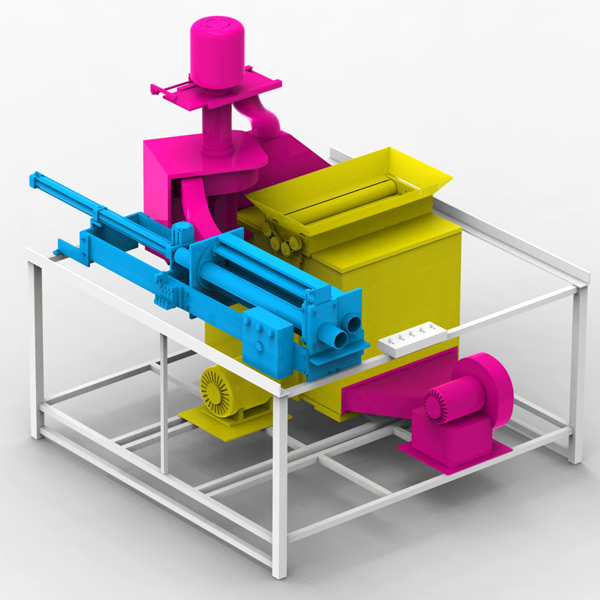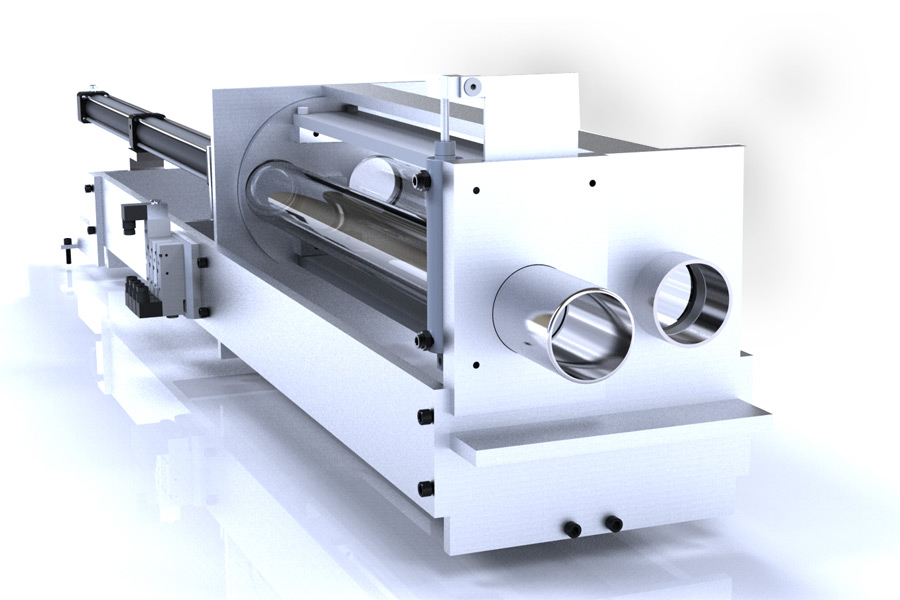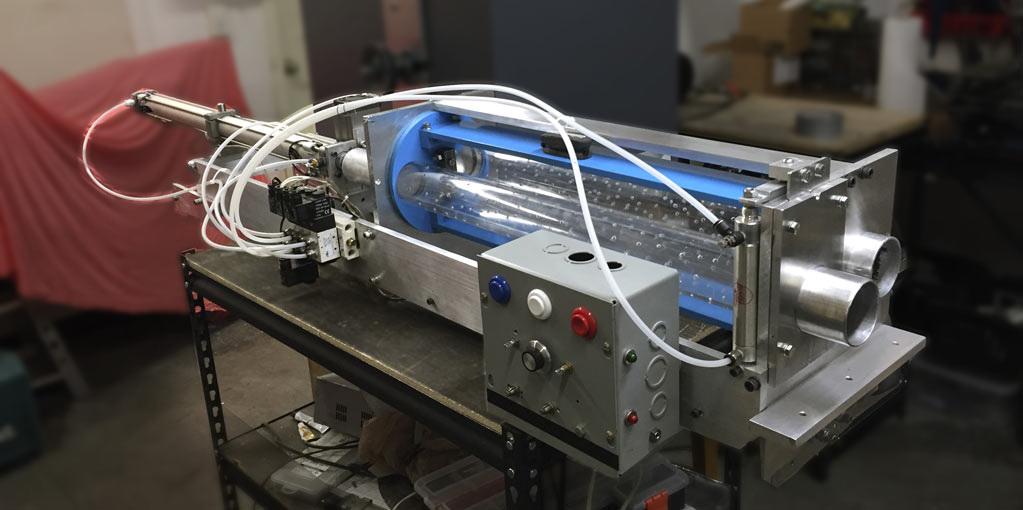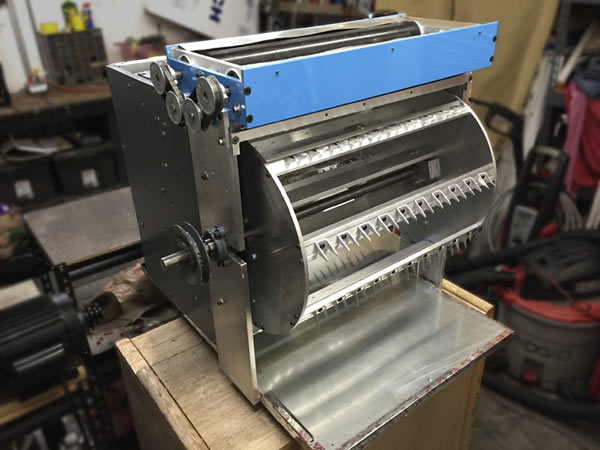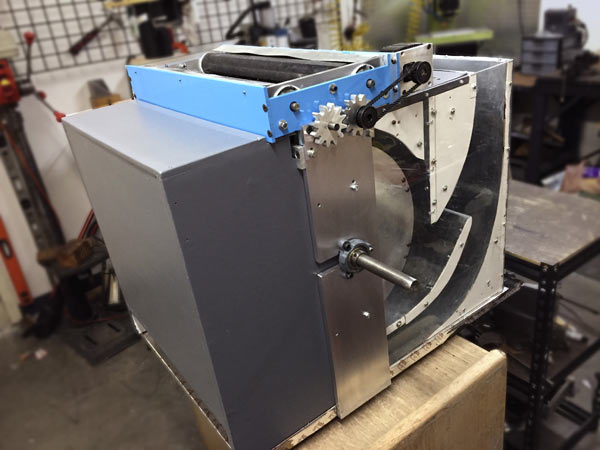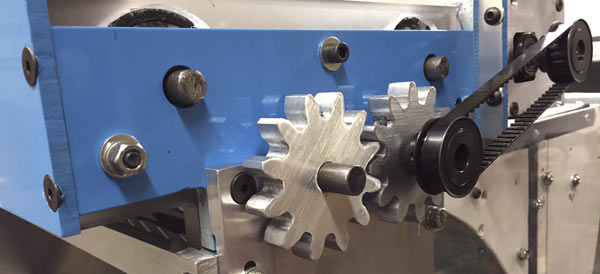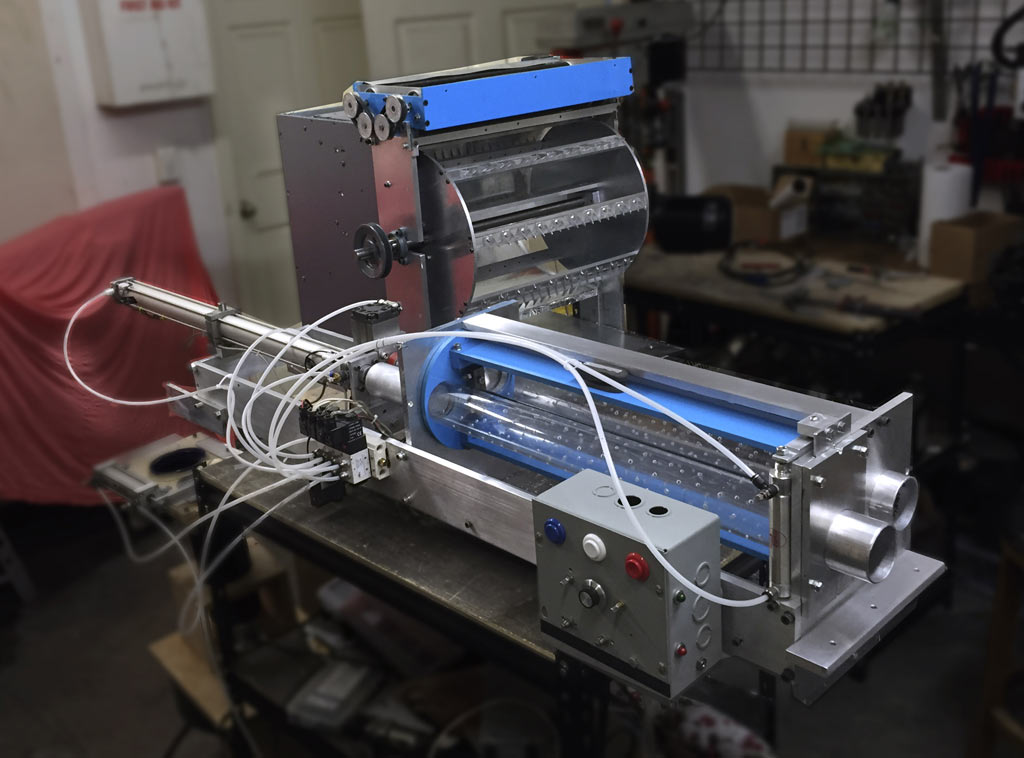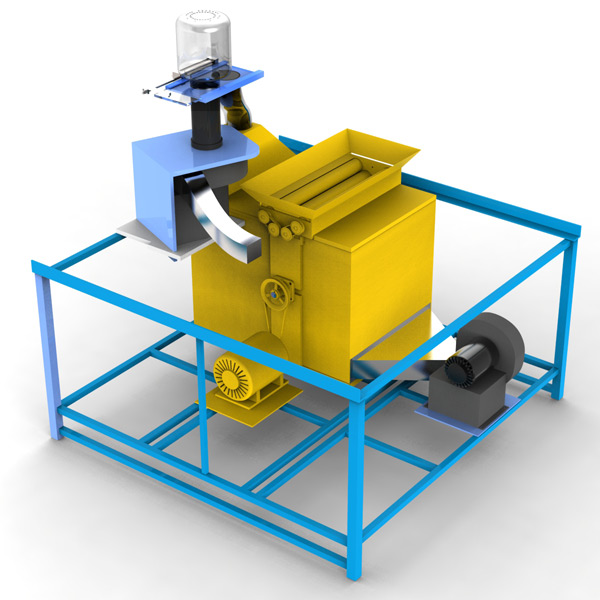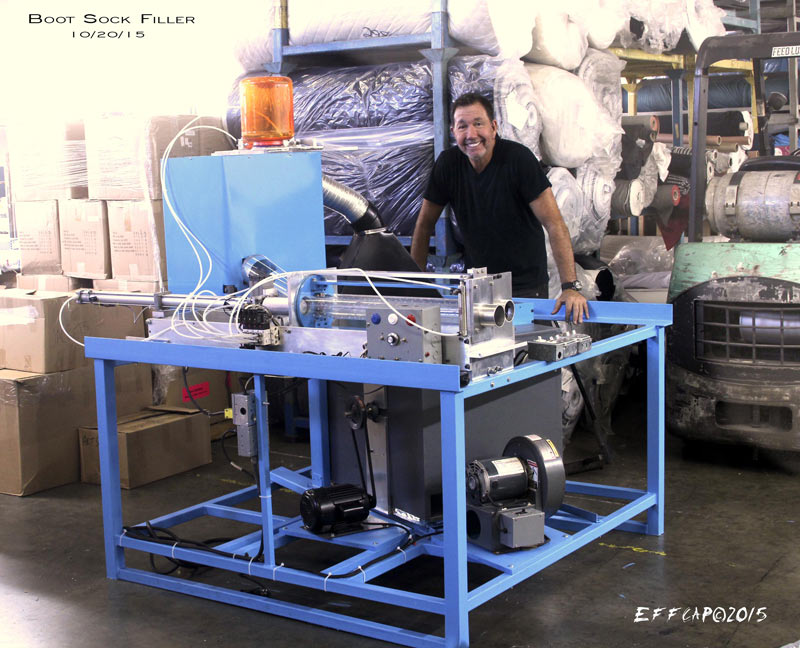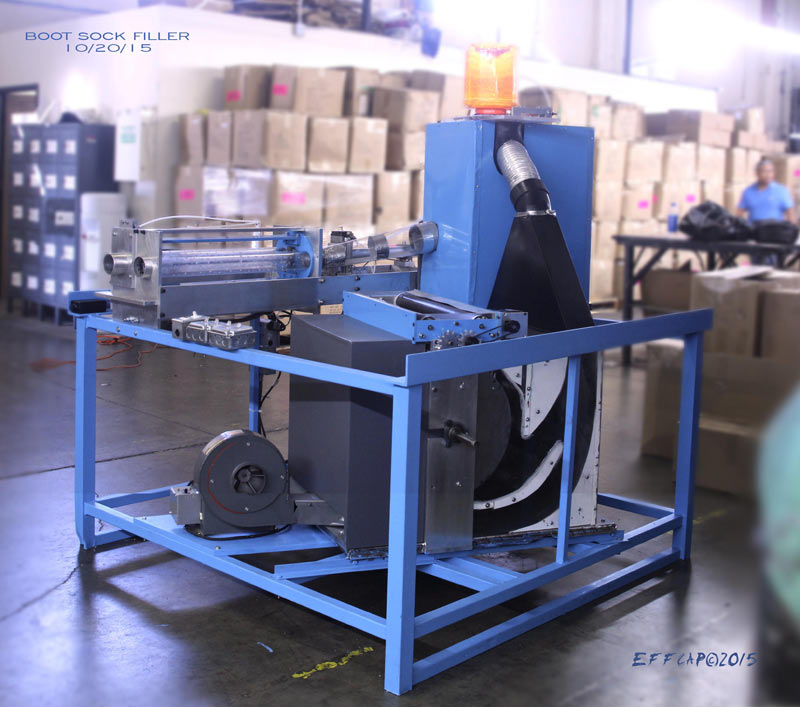GEEK LEVEL – 10
This was the toughest project I’ve ever attempted to date. (November 2015) It started when I was asked by a long time friend’s new husband if there was a way to automate a process being done by hand in his clothing manufacturing plant. That simple challenge turned into a complicated contraption of three machines working in harmony and I have to admit, this one pushed me and my friendship to the breaking point. Lesson learned: Never commit to doing a never-before-seen-prototype for a friend on a budget. This one hurt. Still does. Accepting the challenge was one the few regrets I’ve had in my life.
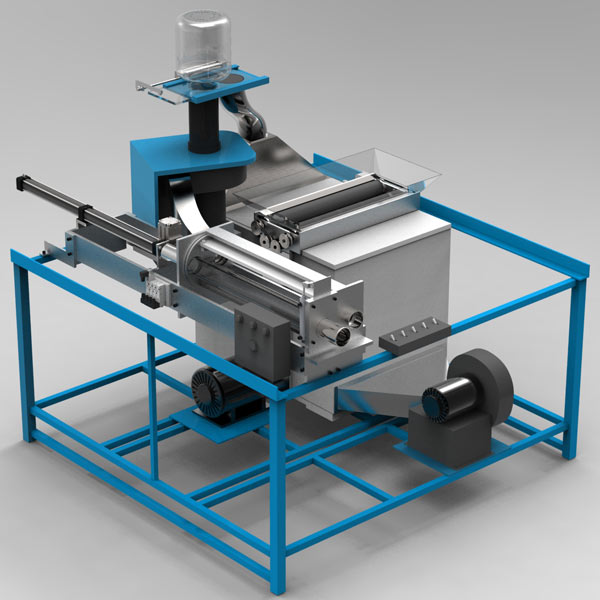 Assignment: Make a machine that will replace the hand labor of stuffing fiberfill (pillow stuffing) into long linen socks designed to keep boots from collapsing in on themselves while not in use.
Assignment: Make a machine that will replace the hand labor of stuffing fiberfill (pillow stuffing) into long linen socks designed to keep boots from collapsing in on themselves while not in use.
Problem 1: These socks have to be very rigid to hold a boot upright which means simply filling them with fiberfill will not work. Almost four times the volume of the sock in fiberfill has to be pushed and compressed inside. Even the most powerful pressure blowers (big fans) won’t work.
Initial Ideal: I quickly decided that some kind of positive displacement pump would probably be the only way to push and compress that much fiberfill into such a small space. A displacement pump is essentially a piston that moves in and out of a cylinder. Through two opposing valves, it draws in product on the backstroke, then pushes it out on the forward stroke. But I don’t recall ever hearing of a pump being used to move pillow stuffing before. I mean this isn’t water. This is thousands of strands of stringy fiber shaped like miniature cotton balls. It snags on everything and you can barely brush it off your clothes!
Research online confirmed my suspicions since I couldn’t find a single instance of a machine made to do what I was now challenged to build. I also discovered very quickly that moving fiberfill around was not going to be as easy as any of us expected.
— My quickie animation to show how the pump might actually work.
<></iframe>
Problem 2: Fiberfill comes in large bags and has been heavily compressed at the plant to fit as much inside the bag as possible. So how do you break up that thick fiberfill and get it to flow smoothly into the pump?
That problem actually became the toughest part of this entire project and forced me to locate machine manuals from the 1800’s, specially on making fabric from bails of raw cotton. It became a long and arduous process of getting the fiber fill ripped apart and air transferred into the narrow long tubes of the pump. I was so frustrated I started watching hours of Youtube college lectures on Fluid Dynamics. That’s what makes some jobs so rewarding – you get to learn so many useless things.
Boot Sock Stuffer Specs:
Fills a sock in 15 seconds as opposed to a 2 minute average by human hands.
Uses three AC motors and one DC motor plus four pneumatic actuators.
Electronics are built from discrete CMOS chips with their higher operating voltage to help suppress the noise of spikes in a sewing machine plant that uses 3 phase 220 VAC.
COMING SOON: IMAGES AND VIDEOS OF THE REAL MACHINE IN ACTION
Let’s get on with it.
The Three Machines of the Boot Sock Stuffer (Click for more detail.)
1: DISPLACEMENT PUMP
The first ever fiberfill displacement pump.
The pump is what pushes – with force – fluffed (more on that later) fiberfill into the sock. The final design came in at over 6 feet in length and looks kind a high tech Gatling gun. How it works is: A 32 inch stroke pneumatic cylinder on the left pushes a 6 inch solid aluminum piston through one of the two clear tubes in the DRUM on the right. The sock to fill slips over the chrome nozzle on the far right. As the piston moves from left to right, it pushes a full tube length of fiberfill into the 12″ long sock. As this is happening the tube next to it is being filled with newly “fluffed – opened” fiberfill. Once the piston retracts, the entire DRUM rotates 180 degrees, giving the piston a fresh tube of fiberfill to push into the sock.
It actually takes three full length strokes to pack enough fiberfill to make the sock hard enough to do its job as a boot stuffer.
BELOW:
Note the rotating DRUM with the two clear tubes at the center of the box in the foreground. That was my way of eliminating the complexity of using two valves feeding one tube.
Actual FiberFill Displacement Pump
2: BEATER BOX
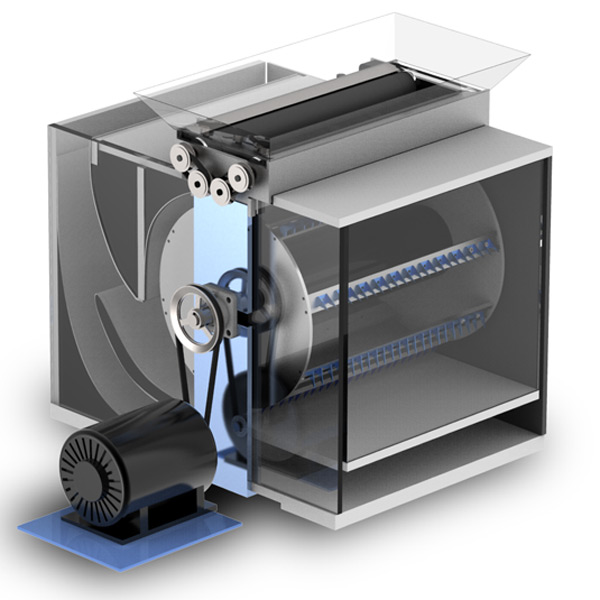 The beater box is a machine that takes the tightly packed fiberfill and rips it apart into small tuffs that can be carried away in a controlled stream of air. On the top is the FIBER FEEDER, a motorized series of gritty surface rollers that pull the fiberfill down and through a thin slit. Just below the slit is the SPIKE DRUM which is rotating at 600 RPM. The spikes grab the fiberfill and pull it apart, spinning it around the drum until it’s light enough to blow off and be taken away by a powerful pressure blower at the front end.
The beater box is a machine that takes the tightly packed fiberfill and rips it apart into small tuffs that can be carried away in a controlled stream of air. On the top is the FIBER FEEDER, a motorized series of gritty surface rollers that pull the fiberfill down and through a thin slit. Just below the slit is the SPIKE DRUM which is rotating at 600 RPM. The spikes grab the fiberfill and pull it apart, spinning it around the drum until it’s light enough to blow off and be taken away by a powerful pressure blower at the front end.
This version is the second one I built for this project. The first one was made from wood and hardware from a local Home Depot. The spikes were roofing nails and there were hundreds of them spinning around in a plywood box at forty miles per hour. I had nightmares of this thing coming apart while testing and nailing everyone within 20 feet.
I machined the second version from aluminum and steel, incorporating a lot of design changes learned through building it wrong. That’s how it goes sometimes when making one of a kind items – you have to actually build it to know how to build it. And even then, you will still be in the experimental stage. Famed designer JAMES DYSON actually went through 5,127 prototypes before getting his dual cyclone bagless vacuum cleaner to work.
TID BIT: The name “Beater Box” came out of my research into the early days of making fabric. The cotton was bundled in bails and was full of dirt and twigs and insects, etc. This “field cotton” was sent into the jaws of spinning SPIKES to be ripped apart (Opened). As these tuffs of cotton flew around the box, it was BEATEN against a series of bars at the bottom, causing the heavier debris to fall through the bars and into a dump vat. The name Beater Box is still used today.
3: AIR MOVER
At the beginning of this project the displacement pump was thought to be the key component to make this one-of-a-kind machine work but in the end it all came down to Air Flow.
It’s easy to understand how a piston will push out a long tube of fiberfill into a sock, it’s another thing to understand how the air needs to move to get the fiberfill into the tubes to begin with.
When I start any project, I like to do some simple tests with household objects, I did a test with a vacuum cleaner and plastic candy tube and found out I’d need very long tubes to get the fiberfill to flow freely inside. I also found out that once the tube would start to fill up, the air would actually blow back and stop any more fiberfill from coming in. To counter this problem I started drilling holes – lots of holes – in the plastic tubes to allow air to escape as each section behind it filled up. Even at 28 inches in length, the tubes would have to be filled and dumped three times to fully fill one 12 inch long sock. Luckily I had anticipated that problem when doing the electronics and put a selector switch to go from one to three cycles per sock fill.
To get everything to finally flow into the tubes took two medium sized (within budget) pressure blowers, a lot of trial and error with ducting and even redoing the Beater Box to keep air from blowing inside and coming out the Fiber Feeder on top.
In theory, the front blower was there to blow air through the Beater Box, creating a vacuum behind the SPIKE DRUM. This vacuum would suck the lighter tuffs of fiberfill from the spinning drum into the higher velocity air stream from that front blower. This air-stream dumped out into a FILL JUG on top that had vent holes as well on top. In reality, the front blower that was purchased on Ebay was not strong enough to create the vacuum needed and will have to be replaced with a much stronger and more expensive blower before this part of the system works correctly. That’s a huge problem in the prototyping world – getting a client to understand that when something has never been done before, the budget has to remain flexible.
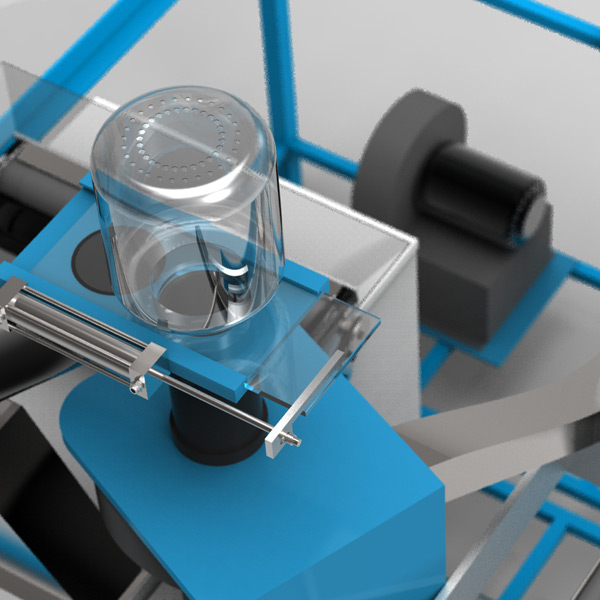 The fill Jug was used to meter the amount of fiberfill to be transferred to the fill tubes.
The fill Jug was used to meter the amount of fiberfill to be transferred to the fill tubes.
The Jug would fill up with fiberfill and that fiberfill would need to be vacuumed out and blown into the fill tube in the pump but how?
I was looking at the problem for a while and suddenly had one of those AHA moments — why not just MOVE the JUG – from the fill pipe to the dump pipe. It was light weight and a small pneumatic cylinder did the trick. Now the airflow system was pretty much complete. The final task would be tweaking the timing of all of the elements to ensure the proper filling of a boot sock.
Boot Sock Stuffer Specs:
Fills a sock in 15 seconds as opposed to a 2 minute average by human hands.
Uses three AC motors and one DC motor plus four pneumatic actuators.
Electronics are built from discrete CMOS chips with their higher operating voltage to help suppress the noise of spikes in a sewing machine plant that uses 3 phase 220 VAC.
PHOTOS OF the final BOOT SOCK FILLER
COMING SOON: VIDEOS OF THE REAL MACHINE IN ACTION
